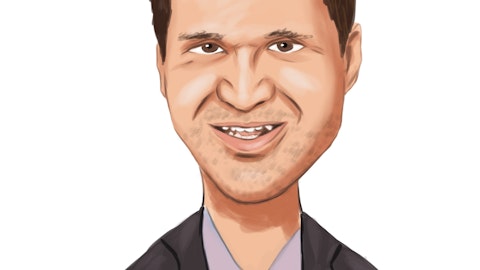John Kim: The yields would have increased just given the change in interest rates?
Meghan Baivier: Yes, I mean the structure that we’re able to underwrite you can hold your economics, but working with the government to improve your economics can get tricky.
John Kim: Okay. Just one final question, a follow-up to Michael on the dividends. Sometimes, REITs have — are influenced by the capital markets, your stock is yielding 9.7% today, which is a huge spread versus the tenure on a very similar credit. How much does the capital markets and your stock price influence or change the way you view the dividend policy?
Darrell Crate: I mean, look, just — I’m not actually sure what the question is. So I think the easiest answer is no, we’re not looking to the capital markets to set our dividend policy. As Meghan said, we’re on the edge of analyzing terrific opportunity for the company. As you’ve seen, we have the most forecastable revenue stream of maybe any REIT in the United States. So, the opportunity and Meghan has done such a great job getting our liabilities priced out. We feel like we have plenty of opportunity in order for us to have a terrific return for shareholders. And we think that will be recognized by the capital markets.
John Kim: Great. Thank you.
Operator: Thank you. Our next question is from Bill Crow of Raymond James. Please proceed with your question.
Bill Crow: Hey, good morning. Meghan, one for you. How much could you acquire on balance sheet before you hit the upper end of your guardrail for leverage assuming of course no equity issuance?
Meghan Baivier: Sure, I think that’s the type of the cap rate environment we’re seeing today, right, you’re going to be kind of in that $150 million to $200 million range.
Bill Crow: Okay. And that’s a pretty firm ceiling, I assume, at this point?
Meghan Baivier: We’ve always been committed to running a BBB profile balance sheet. I think that there’s no intent to change that.
Darrell Crate: Yes, I just like to make a comment, Bill, is that one, and I want to make it very clear that we’re differentiated with regard to our access to capital markets today compared to many REITs because of this durability of cash flow. So, when we’re looking at leverage and leverage ceilings and talking with debt providers I can’t get into specific conversations, but we hear again and again from various sources in the capital markets that given what we’re doing and what we’re looking to do that these are very financeable projects and our opportunity to take on leverage with comfort with debt providers is very high.
Bill Crow: Yes, I think that’s absolutely true and especially true in the private market. But I think as a public REIT, you have another contingency out there that would probably not necessarily agree that higher leverage is better at this point. Let me shift over to the leases that were signed in the quarter, the DEA, the courthouse in Del Rio, and then the ones that were signed on the asset acquisitions that extended the length to another, I think, 10 years, what were the economics of that lease old lease rate to new lease rate change?
Meghan Baivier: Yes. So, Bill, we typically try to create full transparency at the end of the year, but we’re very proud of the renewals we continue to post post-pandemic and in this typical office backdrop. So, what I would share with you is Birmingham and the Courthouse in Del Rio, are bang on the center of our target range and right around that 20% level on a net effective spread and that’s for a 16-year new term.
Bill Crow: So, up 20% from the expiring. And what about the ones that were signed prior to the change in ownership?
Meghan Baivier: Are you referring to the Anaheim, Atlanta?
Bill Crow: Yes, you mentioned the acquisitions where they’re just — the tenants have just signed a new lease extension. I’m just curious how those economics were.
Meghan Baivier: Yes, I’ll have to follow-up with you on that, Bill, and I don’t have that on my fingertips.



